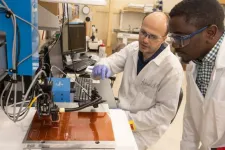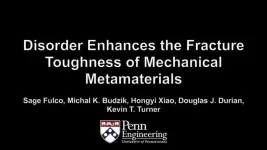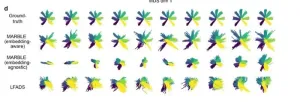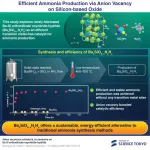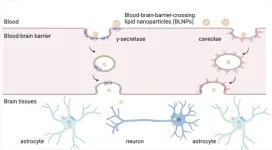(Press-News.org) Amyotrophic lateral sclerosis (ALS) is a fatal neurodegenerative disease with few treatment options. Since 2018, the Sean M. Healey & AMG Center for ALS at Massachusetts General Hospital (MGH), a founding member of the Mass General Brigham healthcare system, has been working with national and international stakeholders to accelerate ALS research by launching the first platform trial in ALS to simultaneously test multiple drugs using shared trial infrastructure and placebo data. Findings from the first four drugs evaluated through the trial are published in papers appearing in JAMA, JAMA Neurology, and JAMA Network Open.
“Recent progress in the clinical sciences has fueled a large pipeline of drugs for ALS that are waiting to be tested,” said Sabrina Paganoni, MD, PhD, co-director of the Neurological Clinical Research Institute (NCRI) at MGH. Paganoni is also an associate professor of Physical Medicine and Rehabilitation at Spaulding Rehabilitation. “For a quickly progressing disease like ALS, trials need to be extraordinarily efficient to bring drugs to patients as rapidly as possible. A platform trial is the perfect approach for doing this.”
Unlike most clinical trials, which are established to test individual treatments, a platform trial takes a disease-based approach. This approach, which has been employed for cancer research, establishes common research protocols and resources to streamline parallel testing of many promising therapies in multi-center, double-blind, placebo-controlled studies.
“This groundbreaking approach has been shown to reduce the time to find an effective treatment by half and decrease costs by a third or more,” said Merit Cudkowicz, MD, MSc, director of the Sean M. Healey & AMG Center for ALS, principal investigator of the HEALEY ALS Platform Trial and executive director of the Mass General Brigham Neuroscience Institute. “It unites patients, clinicians, scientists and industry partners.”
By pooling placebo data across trials, the platform reduces the proportion of patients assigned to placebos to 25 percent, allowing more patients to receive investigational therapies. The platform is perpetual and adaptive, meaning new therapies can be added until effective treatments are identified.
Each of the first four trials included approximately 160 patients, with roughly 120 receiving an investigational drug and 40 receiving a placebo. As phase 2 trials, the goal of these studies was to rapidly assess drug candidates and determine whether to proceed with larger trials. Of the four regimens, two drugs (CNM-Au8 and pridopidine) are moving to phase 3 testing. Though neither met criteria demonstrating statistically significant benefit over 24 weeks, the phase 2 trials showed promising trends in other outcome measures and biomarkers and helped clarify dosage information and target populations, informing the phase 3 design.
“The platform trial is a unique opportunity to work collaboratively with several experts in ALS around the country,” said James Berry, MD, MPH, first author of the paper reporting findings on CNM-Au8, chief of the MGH Division of ALS and Motor Neuron Diseases and co-director of the NCRI. The study of pridopidine was co-led by Jeremy Shefner, MD, PhD, of the Barrow Neurological Institute and Björn Oskarsson, MD, of the Mayo Clinic in Jacksonville, Florida. Shefner, alongside Cudkowicz, co-founded the Northeast ALS (NEALS) Consortium, a key HEALEY ALS Platform Trial collaborator. The other lead investigators of these four studies include Christina Fournier, MD, of Emory University, Jinsy Andrews, MD, of Columbia University, and Nicholas Maragakis, MD, of Johns Hopkins School of Medicine.
The two other drugs tested, zilucoplan and verdiperstat, will not move to phase 3 trials, though deidentified placebo data and samples will be shared in public databases for future research thus supporting additional research in ALS and other neurodegenerative diseases. Three new trials from the platform have completed enrollment, and additional trials will launch in the future.
“These four papers and the initial few years of the platform trial have shown that when people work together, they can achieve more,” said Suma Babu, MBBS, MPH, codirector of the NCRI, who co-led the trial of verdiperstat. “An answer for ALS will not come from one source, but from a larger ecosystem that unites the different pieces that are needed to bring change. There is hope, and there are people working hard to cure this complex disease in the best and most efficient way.”
Disclosures: Full disclosure lists can be found in the four published papers.
Funding: The HEALEY ALS Platform Trial was supported by the AMG Charitable Foundation, Tackle ALS, the ALS Association, ALS Finding a Cure, MDA, ALS ONE, Arthur M. Blank Family Foundation, I AM ALS, Tambourine ALS Collaborative Cohort, and many other community fundraising initiatives and donors. Study drug and additional funding was provided by UCB, Biohaven, Clene Nanomedicine and Prilenia.
Papers cited:
Paganoni S et al. “Efficacy and Safety of Zilucoplan in Amyotrophic Lateral Sclerosis A Randomized Clinical Trial” JAMA Network Open DOI: 10.1001/jamanetworkopen.2024.59058
Writing Committee for the HEALEY ALS Platform Trial. “Verdiperstat in Amyotrophic Lateral Sclerosis Results From the Randomized HEALEY ALS Platform Trial” JAMA Neurology DOI: 10.1001/jamaneurol.2024.5249
Writing Committee for the HEALEY ALS Platform Trial. “CNM-Au8 in Amyotrophic Lateral Sclerosis Results From the HEALEY ALS Platform Trial” JAMA DOI: 10.1001/jama.2024.27643
Writing Committee for the HEALEY ALS Platform Trial. “Pridopidine in Amyotrophic Lateral Sclerosis Results From the HEALEY ALS Platform Trial” JAMA DOI: 10.1001/jama.2024.26429
###
About Mass General Brigham
Mass General Brigham is an integrated academic health care system, uniting great minds to solve the hardest problems in medicine for our communities and the world. Mass General Brigham connects a full continuum of care across a system of academic medical centers, community and specialty hospitals, a health insurance plan, physician networks, community health centers, home care, and long-term care services. Mass General Brigham is a nonprofit organization committed to patient care, research, teaching, and service to the community. In addition, Mass General Brigham is one of the nation’s leading biomedical research organizations with several Harvard Medical School teaching hospitals. For more information, please visit massgeneralbrigham.org.
END
Accelerated drug-testing platform for ALS paves way for therapeutic innovation
The ongoing HEALEY ALS Platform Trial completed evaluations of its first four treatment regimens, using a common research setup that makes trials more efficient and cost-effective to bring treatments to patients faster
2025-02-17
ELSE PRESS RELEASES FROM THIS DATE:
Pancreatic cancer: blocked nerves as a possible new treatment strategy
2025-02-17
Pancreatic cancer is fueled by connections to the nervous system. This is reported by scientists from the German Cancer Research Center (DKFZ) and the Heidelberg Institute for Stem Cell Technology and Experimental Medicine (HI-STEM)* in their current publication in Nature. The team discovered that the tumor specifically reprograms the neurons for its own benefit. In mice, blocking nerve function inhibited cancer growth and increased the sensitivity of tumor cells to certain chemotherapies and immunotherapies.
For several years, ...
This research is absolutely nuts – for better health care
2025-02-17
A nut used in herbal tea has become a hydrogel perfect for a variety of biomedical uses in new research from the University of Chicago Pritzker School of Engineering (UChicago PME) and UChicago Chemistry Department.
A paper published today in Matter created a malva nut hydrogel for medical uses ranging from wound care to ECG readings. The research doesn’t rely on the rumored health benefits of the nuts – in China, they’re known as the sore throat remedy Pangdahai (PDH) – but for their ability to swell in water.
“You never saw the fruit from a tree expand in that kind of volume,” said first ...
Genetic study links defects in sugar digestion to irritable bowel syndrome
2025-02-17
Sucrase-isomaltase (SI) is an intestinal enzyme critical for the digestion of dietary carbohydrates, particularly sucrose and starch. Previous studies from the Gastrointestinal Genetics team at CIC bioGUNE - BRTA and LUM University suggested a genetic link between SI defects and IBS, whereby certain DNA changes cause reduced enzymatic activity and inefficient digestion of carbohydrates, thus inducing symptoms like bloating, diarrhoea, and abdominal pain. As the name gives away, however, SI is a special case in that it encompasses two enzymes with different carbohydrate-digesting ...
Binghamton University, State University of New York retains top research ranking among elite universities
2025-02-17
BINGHAMTON, N.Y. -- Binghamton University maintains its status as an R1 institution for its prolific research activity, according to a new list from the Carnegie Classification of Institutions of Higher Education.
Every three years, the Carnegie Classification looks at schools’ research expenditures and graduate programs to evaluate which campuses can be considered an R1 institution for “very high spending and doctorate production.”
Schools with this designation must spend at least $50 million on research and development and award at least 70 research doctorates. Binghamton wrapped ...
Breaking the pattern: How disorder toughens materials
2025-02-17
Cut open a bone and you’ll see a subtly disordered structure. Tiny beams, called trabeculae, connect to one another in irregular patterns, distributing stress and lending bones an impressive toughness. What if human-made materials could exhibit similar properties?
In a new paper in Proceedings of the National Academy of Sciences Nexus, researchers at Penn Engineering, Penn Arts & Sciences and Aarhus University found that adding just the right amount of disorder to the structure of certain materials can make them more than twice as resistant to cracking.
The finding opens the door to more widespread use of so-called “mechanical metamaterials,” ...
A geometric deep learning method for decoding brain dynamics
2025-02-17
In the parable of the blind men and the elephant, several blind men each describe a different part of an elephant they are touching – a sharp tusk, a flexible trunk, or a broad leg – and disagree about the animal’s true nature. The story illustrates the problem of understanding an unseen, or latent object based on incomplete individual perceptions. Likewise, when researchers study brain dynamics based on recordings of a limited number of neurons, they must infer the latent patterns of brain dynamics that generate these recordings.
“Suppose you and I both engage in a mental task, ...
Novel catalyst development for sustainable ammonia synthesis
2025-02-17
As the world moves toward sustainability, the demand for efficient alternatives across industries continues to grow. Ammonia, a key chemical used in fertilizers, explosives, and various other products, is primarily synthesized through the energy-intensive Haber-Bosch process. This process requires extremely high temperatures and pressures, contributing to global carbon dioxide emissions. Conventional catalysts, such as iron and ruthenium, rely on these harsh conditions to drive the reaction. However, a recent study by researchers from Institute of Science Tokyo, the National Institute for Materials Science, and Tohoku University, Japan, led by Professor Masaaki Kitano, explores ...
Researchers identify DNA changes, biological pathways associated with inherited cancer risk
2025-02-17
Thousands of single changes in the nucleotides that make up the human genome have been associated with an increased risk of developing cancer. But until now, it’s not been clear which are directly responsible for the uncontrolled cellular growth that is the hallmark of the disease and which are simply coincidences or minor players.
Stanford researchers have conducted the first large-scale screen of these inherited changes, called single nucleotide variants, and homed in on fewer than 400 that are essential to initiate and drive cancer growth. These variants control several common biological ...
New lipid nanoparticle platform delivers mRNA to the brain through the blood-brain barrier
2025-02-17
New York, NY [February 17, 2025]—Scientists at the Icahn School of Medicine at Mount Sinai have developed a lipid nanoparticle system capable of delivering messenger RNA (mRNA) to the brain via intravenous injection, a challenge that has long been limited by the protective nature of the blood-brain barrier.
The findings, in mouse models and isolated human brain tissue, were published in the February 17 online issue of Nature Materials [10.1038/s41563-024-02114-5]. They demonstrate the potential of this technology to pave the way for ...
Wildfires in the Andes cause severe soil degradation and hinder ecosystem recovery
2025-02-17
In September 2018, a wildfire burned nearly two thousand hectares of shrubland on the Pichu Pichu volcano, an ecologically significant area in the Peruvian Andes. Unlike Mediterranean ecosystems, where vegetation has evolved strategies to withstand fire, the volcanic soils of Arequipa—one of the driest regions in the world—are not adapted to wildfire disturbances. A Miguel Hernández University of Elche (UMH) research team collected and analyzed soil samples from the burned area at 3,700 meters above sea level to understand how these fragile ecosystems ...
LAST 30 PRESS RELEASES:
Jeonbuk National University study shows positive parenting can protect adolescents against self-harm
Surface-engineered ZnO nanocrystals to tackle perfluoroalkyl substance contamination
This new understanding of T cell receptors may improve cancer immunotherapies
A new fossil face sheds light on early migrations of ancient human ancestor
A new immunotherapy approach could work for many types of cancer
A new way to diagnose deadly lung infections and save lives
40 percent of MRI signals do not correspond to actual brain activity
How brain-inspired algorithms could drive down AI energy costs
Gum disease may be linked to plaque buildup in arteries, higher risk of major CVD events
Contrails are a major driver of aviation’s climate impact
Structure of dopamine-releasing neurons relates to the type of circuits they form for smell-processing
Reducing social isolation protects the brain in later life
Keeping the heart healthy increases longevity even after cancer
Young adults commonly mix cannabis with nicotine and tobacco
Comprehensive review illuminates tau protein's dual nature in brain health, disease, and emerging psychiatric connections
Book prepares K-12 leaders for the next public health crisis
Storms in the Southern Ocean mitigates global warming
Seals on the move: Research reveals key data for offshore development and international ecology
Sports injuries sustained during your period might be more severe
World's first successful 2 Tbit/s free-space optical communication using small optical terminals mountable on satellites and HAPS
Can intimate relationships affect your heart? New study says ‘yes’
Scalable and healable gradient textiles for multi‑scenario radiative cooling via bicomponent blow spinning
Research shows informed traders never let a good climate crisis go to waste
Intelligent XGBoost framework enhances asphalt pavement skid resistance assessment
Dual-function biomaterials for postoperative osteosarcoma: Tumor suppression and bone regeneration
New framework reveals where transport emissions concentrate in Singapore
NTP-enhanced lattice oxygen activation in Ce-Co catalysts for low-temperature soot combustion
Synergistic interface engineering in Cu-Zn-Ce catalysts for efficient CO2 hydrogenation to methanol
COVID-19 leaves a lasting mark on the human brain
Scientists use ultrasound to soften and treat cancer tumors without damaging healthy tissue
[Press-News.org] Accelerated drug-testing platform for ALS paves way for therapeutic innovationThe ongoing HEALEY ALS Platform Trial completed evaluations of its first four treatment regimens, using a common research setup that makes trials more efficient and cost-effective to bring treatments to patients faster

